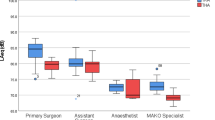Abstract
In the process of surgery, operation equipments or materials inevitably rub against the internal organs or tissues of patient, which often causes a series of frictional trauma problems. However, research work on the tribological factors at the interface and subsequent friction trauma is still very limited. In this paper, the friction trauma mechanism of small intestine caused by the surgeon’s fingers in the process of grasping and pulling operation was investigated in vivo by means of reciprocal sliding friction testing. The rabbit small intestine was used to simulate human small intestine. An UMT-II tribometer was used to measure tribological parameters of the rabbit small intestine under different normal force of 1.0, 2.0 and 3.0 N to simulate the grip strength of surgeon’s hands. Histological analysis was used to evaluate the degree of tissue damage. Results showed that the ratio of tangential force to normal force of rabbit small intestine decreased with the normal force increasing. The frictional behavior under the three normal forces was all in the tissue damage range of intermediate regime from sticking to relative sliding. With the normal force and friction time increasing, the total friction energy dissipation on the small intestine increased, which induced the damage degree of the small intestine aggravation. The damage of rabbit small intestine extended gradually from outside to inside: serosa layer tearing and falling, muscularis bleeding, longitudinal muscularis and circular muscularis division and mucosal bleeding and necrosis.











Similar content being viewed by others
References
Complications of colonoscopy: Gastrointest. Endosc. 57, 441–445 (2003)
Silvis, S.E., Nebel, O., Rogers, G., Sugawa, C., Mandelstam, P.: Endoscopic complications: results of the 1974 American Society for Gastrointestinal Endoscopy survey. JAMA 235, 928–930 (1976)
Jentschura, D., Raute, M., Winter, J., Henkel, T., Kraus, M., Manegold, B.C.: Complications in endoscopy of the lower gastrointestinal tract. Surg. Endosc. 8, 672–676 (1994)
Araghizadeh, F.Y., Timmcke, A.E., Opelka, F.G., Hicks, T.C., Beck, D.E.: Colonoscopic perforations. Dis. Colon Rectum 44, 713–716 (2001)
Garbay, J.R., Suc, B., Rotman, N., Fourtanier, G., Escat, J.: Multicentre study of surgical complications of colonoscopy. Br. J. Surg. 83, 42–44 (1996)
Gatto, N.M., Frucht, H., Sundararajan, V., Jacobson, J.S., Grann, V.R., Neugut, A.I.: Risk of perforation after colonoscopy and sigmoidoscopy: a population-based study. J. Natl Cancer Inst. 95, 230–236 (2003)
Korman, L.Y., Overholt, B.F., Box, T., Winker, C.K.: Perforation during colonoscopy in endoscopic ambulatory surgical centers. Gastrointest. Endosc. 58, 554–557 (2003)
Farley, D.R., Bannon, M.P., Zietlow, S.P., Pemberton, J.H., Ilstrup, D.M., Larson, D.R.: Management of colonoscopic perforations. Mayo Clin. Proc. 72, 729–733 (1997)
Caspi, B., Rabinerson, D., Appleman, Z., Kaplan, B.: Penetration of the bladder by a perforating intrauterine contraceptive device: a sonographic diagnosis. Ultrasound Obstet. Gynecol. 7, 458–460 (1996)
Irvin, W., Rice, L., Taylor, P., Andersen, W., Schneider, B.: Uterine perforation at the time of brachytherapy for carcinoma of the cervix. Gynecol. Oncol. 90, 113–122 (2003)
Chau, M.T., Ghan, F.Y., Pun, T.C., Leong, L.: Perforation of the uterus by an invasive mole using color Doppler ultrasound: case report. Ultrasound Obstet. Gynecol. 3, 51–53 (1993)
Li, F.: Diagnosis and treatment of injury amenorrhea of curettage surgery 28 examples. J. Chin. Tradit. Chin. Med. Inf. 217, 43–47 (2010)
Simmy, T., Anup, R., Prabhu, R., Balasubramanian, K.A.: Effect of surgical manipulation of the rat intestine on enterocyte populations. Surgery 130, 479–488 (2001)
Simmy, T., Prabhu, R., Balasubramanian, K.A.: Surgical manipulation of the intestine and distant organ damage-protection by oral glutamine supplementation. Surgery 137, 48–55 (2005)
Kalff, J.C., Schraut, W.H., Simmons, R.L., Bauer, A.J.: Surgical manipulation of the gut elicits an intestinal muscularis inflammatory response resulting in postsurgical ileus. Ann. Surg. 228, 652–663 (1998)
Wang, X., Meng, M.Q.H.: Study of frictional properties of the small intestine for design of active capsule endoscope. Biomedical Robotics and Biomechatronics, 2006. BioRob 2006. The First IEEE/RAS-EMBS International Conference on. IEEE, pp. 124–129 (2006)
Kim, J.S., Sung, I.H., Kim, Y.T., Kwon, E.Y., Kim, D.E., Jang, Y.H.: Experimental investigation of frictional and viscoelastic properties of intestine for micro endoscope application. Tribol. Lett. 22, 143–149 (2006)
Frank, T., Willetts, G.J.: Clamping the small intestine during surgery: predicted and measured sealing forces. Proc. Inst. Mech. Eng. 209, 111–115 (1995)
Accoto, D., Stefanini, C., Phee, L., Arena, A.: Measurement of the frictional properties of the gastrointestinal tract. World Tribology Congress (2001)
Kazuto, T., Rei, S., Takayuki, K., Hiroki, T., Kiyoshi, Y., Ken, I.: Contact and friction between catheter and blood vessel. Tribol. Lett. 40, 319–328 (2007)
De, S., Rosen, J., Dagan, A., Hannaford, B.: Assessment of tissue damage due to mechanical stresses. Int. J. Robot. Res. 26, 1159–1171 (2007)
Tay, B.K., Kim, J., Srinivasan, M.A.: In vivo mechanical behavior of intra-abdominal organs. IEEE Trans. Biomed. Eng. 53, 2129–2138 (2006)
Gao, T.W., Shun, J.F.: Current dermatopathology. People Hygiene Press, Beijing (2001)
Miyake, H.: Comparison of surgical stress between laparoscopy and open surgery in the field of urology by measurement of humoral mediators. Int. J. Urol. 9, 329–333 (2002)
Cotran, K., V, Kumar, Collins, T.: Pathological Basis of Disease, Sixth edition edn. W. B. Saunders Company, Philadelphia, PA. (1999)
Li, W., Qu, S.X., Zhou, Z.R.: Reciprocating sliding behavior of human skin in vivo at lower number of cycles. Tribol. Lett. 23, 165–170 (2006)
Zhang, M., Mak, A.F.T.: In vivo friction properties of human skin. Prosthet. Orthot. Int. 23, 135–141 (1999)
Sivamani, R.K., Goodman, J., Gitis, N.V., Maibach, H.I.: Friction coefficient of skin in real-time. Skin Res Technol. 9, 235–239 (2003)
Kwiatkowska, M., Franklin, S.E., Hendriks, C.P., Kwiatkowski, K.: Friction and deformation behaviour of human skin. Wear 267, 1264–1273 (2009)
Acknowledgments
This work was supported by National Natural Science Foundation of China (Nos. 51175440 and 51290291).
Author information
Authors and Affiliations
Corresponding author
Rights and permissions
About this article
Cite this article
Li, W., Shi, L., Deng, H. et al. Investigation on Friction Trauma of Small Intestine In Vivo Under Reciprocal Sliding Conditions. Tribol Lett 55, 261–270 (2014). https://doi.org/10.1007/s11249-014-0356-6
Received:
Accepted:
Published:
Issue Date:
DOI: https://doi.org/10.1007/s11249-014-0356-6




